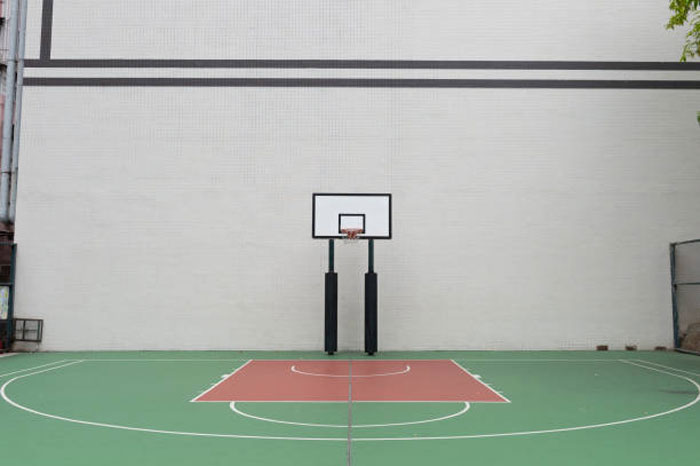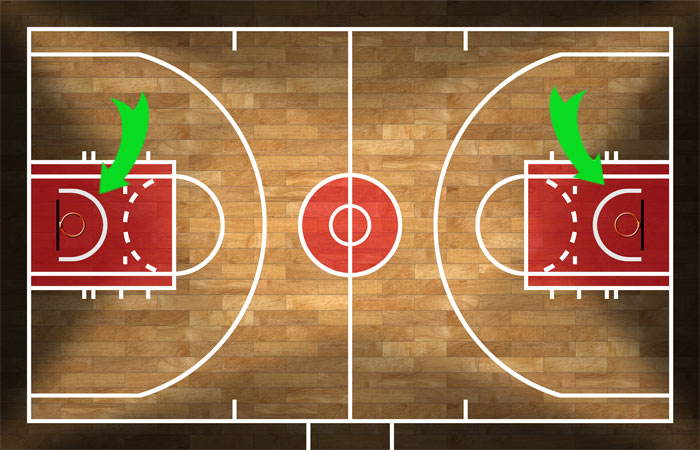When looking at a basketball court, you may notice a strikingly different stretch of color beneath both hoops compared to the rest of the ground.
Analysts and commentators usually reference this area during the play to highlight critical parts and positioning of players in the game. A frequent question new enthusiasts have is, what is the paint in basketball?
It is easily identifiable through its unique color and is a rectangular shape extending from the baseline to the free-throw line.
This article discusses why the paint is such a prime spot for basketball and which rules it helps enforce.
Significance of the Paint
The location of the paint makes it easier for players to score. However, a defensive line surrounds the hoop, blocking attacks from the opponent.
During an offensive play, players try to get past the defense by placing their own players in the surrounding area. Usually, the central player of a team goes to the paint, where teammates pass him the ball.
The taller the player, the easier it is to score from farther away.

Components of the Paint
This part of the basketball court holds various other fundamental areas that are necessary for advancing a strategy and defending against it.
The Restricted Area
The restricted area falls within the paint and is set apart by an arc. Defensive players aren’t allowed within this sector to prevent them from instigating a foul from the opponent.
It was first introduced in the NBA in 1997 and measures four feet in every direction directly beneath the basket. Other leagues also have similarly restricted areas with slightly varying dimensions.
The High Post
The high post is present on the upper end of the paint near the free-throw line. It is split into two areas at both inner corners of the free-throw line. Both offensive and defensive players use the high post as a strategic ground to prevent scores or make shots.
The Low Post
Similarly, the low post is present at the lower end of the paint, slightly ahead of the restricted arc. While the restricted arc is directly within the paint, the low post is on the lane lines. These connect the free-throw line with the baseline.
Offensive players usually use this area to catch a pass and attempt to score from directly underneath the basket.
A Brief History of the Paint
While we refer to it as “the paint” because of its distinctive color, it didn't always go by this name. Fans called the area "the key" in the early days of basketball since it resembled a keyhole.
Some leagues and players also refer to it as “the lane.” This is because the free-throw line and the baseline join through two “lanes.”
The free-throw line, which marks the boundary of the paint, is 15 feet from the backboard.
The dimensions of the key differ slightly for different leagues. The NBA and FIBA have a standard 16 feet wide paint that goes two inches beyond the free-throw line.
The restricted arc, which is 4 inches in diameter, is present directly underneath the basket and was introduced in 1997.
FIBA modified the paint in 2010 with the most recent change. Furthermore, the international league changed the shape of its paint to that of the NBA.
Rules and Regulation of the Paint
As basketball has progressed, so have the rules of the game. The paint has seen a similar advancement in regulations, and there are several restrictions present when playing in the paint.
The 3-second rule is the foremost of the regulations. This rule only allows players to stay within the paint for three seconds maximum. The count resets if a player leaves the area and re-enters again.
Many players have used this to their advantage and stayed within for an extended period by vacating and immediately returning.

It was first introduced in 1936 by the NCCA. During a standard college game, a player named Leroy Edwards played overwhelmingly and wouldn't budge from the paint. The opposing team's defense could not get past him and started relying on fouls to do so.
While Edwards went on to win the National Player of the Year award, his play resulted in the creation of the 3-second rule.
While this was initially only in place for offensive players, the NBA recently changed the rules to add defensive members to it as well.
There are paint violations that may occur during a free throw as well. The offensive and defensive players must stand outside the paint during the throw.
If a player from the offensive enters the paint before the ball leaves the shooter’s hand, the referee negates the point, whether the shooter scored or not.
If a defensive player enters the paint before the throw, the offensive team gets another free shot.
What is the Purpose of the Paint?
The area under the backboard is colored to signify the site’s specific location, and referees use it to implement certain rules and regulations.
Players also try to score from the paint as the probability of the ball landing in the basket is higher. Moreover, players require the paint to perform certain famous basketball techniques.
In a dunk, the player has to hoist himself directly beneath the basket. To complete it successfully, either one or both hands of the player need to be touching the hoop, which is only possible from the paint.

Strategic Uses of the Paint
The paint’s location directly under the backboard and the 3-second rule make the area an essential strategic point. Teams often plan their games ahead of time to make use of this area to score.
Teams usually place their bulkiest player near the opponent’s paint for the offensive. The team tries to get the ball to this player, who attempts to score from his location at the paint.
Plays in this location are the most active, with players from both teams aiming to outplay the other. The crowd is also the most alive, and fans are on the edge of their seats during such moments. The players battle each other for the ball and have the highest chance of committing a foul.
Defense is also strongest around the paint. Teams place two to three of their players near the area. If an opposing player tries to score, a defender will immediately obstruct him.
The high and low posts are also important strategic locations near the hoop. The offensive player usually stands on either of the two sites, facing away from the backboard. Once the player has the ball, they pivot and attempt to score by dunking or through a layup.
Use of the Paint During Free Throws
The free-throw line borders the top-most part of the paint. When a player commits a foul, the opponent team receives a bonus.
A bonus entails two free throws in the NBA and FIBA. The second bonus is only available for NCAA and High School Basketball if the players score the first.
The shooter stands on the free-throw line outside the paint and shoots the ball for the hoop. The defenders and offensive players also stand alongside the lanes connecting the free-throw line with the baseline.
Hash points are present on the lanes and are 3 inches apart from each other. These signal where the players are to stand during a free throw. As soon as the ball leaves the shooter's hand, the players rush onto the paint to secure it.
Conclusion: Paint Basketball
The paint, also known as the key or the lane, is an essential part of the basketball court. It stretches from directly beneath the backboard to the free-throw line 15-feet away.
The paint is also a critical strategic point. Players plan the game around the area and use it to try and score from the closest point to the hoop.
There are a number of rules in place to prevent players from misusing this area of the court. One of these is the 3-second rule which prohibits players from staying within the paint for more than three seconds.
The key is also the area with the most defense. Around two to three players surround the paint to prevent any opponent from getting close.
You might also like: Everything You Need to Know About the 3-Point Line
